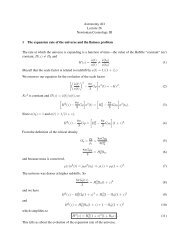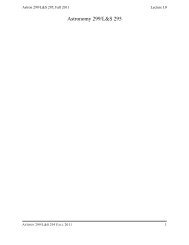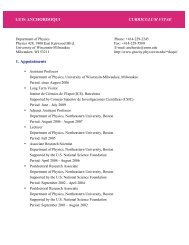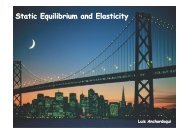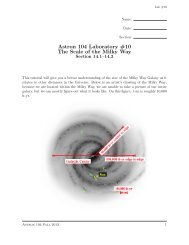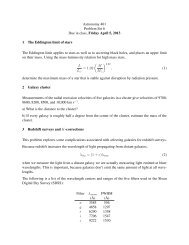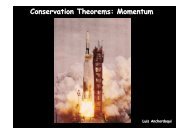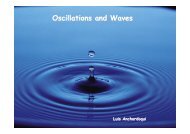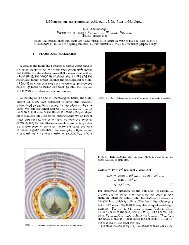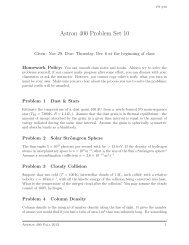Non-Euclidean geometry and the Robertson-Walker metric
Non-Euclidean geometry and the Robertson-Walker metric
Non-Euclidean geometry and the Robertson-Walker metric
You also want an ePaper? Increase the reach of your titles
YUMPU automatically turns print PDFs into web optimized ePapers that Google loves.
Next we substitute r = a(t)x, where a(t) is <strong>the</strong> scale factor <strong>and</strong> x is <strong>the</strong> comoving coordinate:<br />
[( )<br />
(dl) 2 = a 2 dx 2 ]<br />
(t) √ + (x dθ) 2 + (x sin θ dφ) 2<br />
1 − Kx 2<br />
(15)<br />
Finally, we are measuring distances in spacetime, not just space. By distance, we mean <strong>the</strong> proper distance<br />
between two spacetime events that occur simultaneously, according to an observer. The spacetime <strong>metric</strong> is<br />
(ds) 2 = (c dt) 2 − (dl) 2 . (16)<br />
Therefore, we have<br />
[( )<br />
(ds) 2 = (c dt) 2 − a 2 dx 2 ]<br />
(t) √ + (x dθ) 2 + (x sin θ dφ) 2<br />
1 − Kx 2<br />
(17)<br />
This is <strong>the</strong> <strong>Robertson</strong>-<strong>Walker</strong> <strong>metric</strong>, <strong>and</strong> it is used to determine <strong>the</strong> spacetime interval between two events<br />
in any homogeneous, isotropic space (both positively <strong>and</strong> negatively curved, though we only showed it for<br />
<strong>the</strong> simplest, spherical case here).<br />
Also note that <strong>the</strong> curvature parameter K is <strong>the</strong> K that appears in <strong>the</strong> Friedmann equation,<br />
[(ȧ(t)<br />
a(t)<br />
) 2<br />
− 8π 3 Gρ ]<br />
a 2 (t) = −Kc 2 . (18)<br />
In our Newtonian derivation of this equation, K referred to <strong>the</strong> total energy of <strong>the</strong> universe, but when this<br />
equation is derived from general relativity, K is <strong>the</strong> curvature constant defined above. Thus if K = 0,<br />
<strong>the</strong> space is <strong>Euclidean</strong>, i.e. flat. If K > 0, 1/ √ K can be interpreted as <strong>the</strong> radius of curvature of <strong>the</strong><br />
three-dimensional space; <strong>the</strong> two-dimensional analogy is <strong>the</strong> surface of a sphere. If K < 0, <strong>the</strong> space is<br />
hyperbolic—<strong>the</strong> open <strong>geometry</strong> shown in Figure 1.<br />
4





